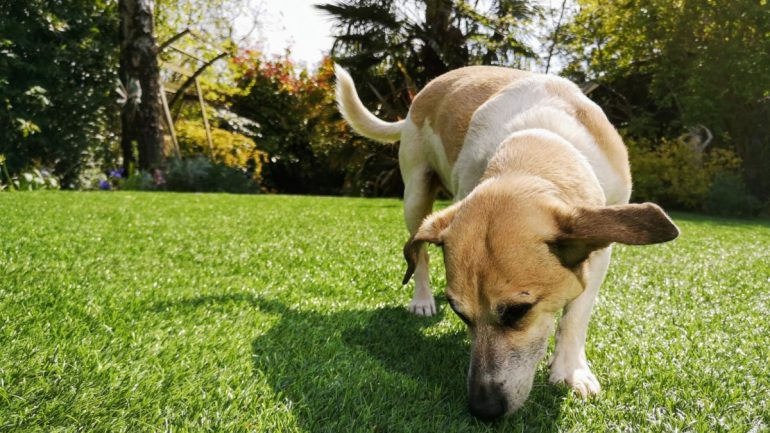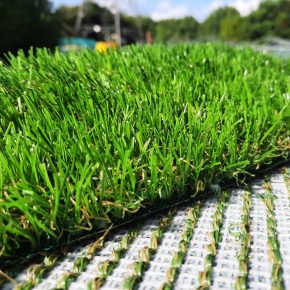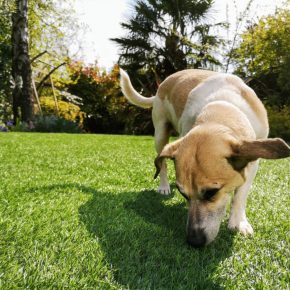There is something about artificial lawns that inspires strong and negatively biased opinions. Apocalyptic images of large swathes of land being covered in plastic, melting in the heat, and choking the local wildlife, give a false impression of what is actually a highly versatile and durable product. Despite its reputation, artificial grass is a viable alternative ground-covering option for outside spaces or on private or commercial landscaping projects.
Helped or hindered (we haven’t decided yet) by the influencer Mrs Hinch and nightly images of the fake grassed Love Island and Big Brother gardens filling our screens, artificial grass has probably garnered more interest than it probably deserves.
Last spring, Welsh climate change minister, Julie James proposed banning the use of artificial lawns completely in public places in Wales (except sports facilities, I understand). The minister is likening it to single-use plastics and is using this argument as a premise for an outright ban, despite the fact that it does not meet any of the definitions of single-use plastic. (This proposal has since been withdrawn).
In mainstream media, barely a week goes by without someone launching another tirade or campaign against artificial grass.
Believe it or not, I welcome all these endeavours with open arms. They give us the perfect opportunity to attempt to set the record straight and make a more balanced case for using this product.
Quality over quantity
I don’t believe any self-respecting builder wants to see the country blanketed in plastic. Even the team at Artificial Lawn Company actively works against its excessive use. People have been saying the same thing about concrete for years – yet there is no talk about banning concrete.
There is no either-or choice with artificial grass. Rather, we see it as an alternative ground covering material that can be incorporated into an overall landscape design in the same way as paving, gravel, or any other aggregate. It’s fully porous, and in most cases can be much better than concreting or paving an entire garden.
The colour, texture, durability, and longevity of artificial grass are all features that make it as good a material as any. And if you take into account its low maintenance qualities. It is ideal when creating homes for older people, those with disabilities, on social housing projects and helping most families with pets or children who will otherwise struggle to maintain and grow a real lawn.
Biodiversity does not have to be compromised. Clever landscaping can incorporate native plants, bug hotels, feeders and other installations that attract insect life to revive and rebalance whatever may have been previously lost.
Quality is key – when cheaper, low-grade fake grass is used, issues around poor performance and long-term sustainability start to be raised. Chances are the cheaper fake grass is simply hiding a whole heap of other issues under the surface.
However, a premium artificial lawn product can still have that immediate aesthetic finish and will continue to have it for many years to come with minimum maintenance required. We have customers and lawns that are still going strong after 20 years.
Working towards greater sustainability
While the artificial lawn industry is investing in improving the recycling infrastructure for the product, we make sure that our own lawns are as durable and hard-wearing as possible to get the maximum use out of them, with a lifespan of up to 20 years and more. Artificial Lawn Company has recently launched its own fully recyclable product. And in 2024 we will be working with “Lets Recycle Artificial Grass” to recycle all our latex backed products at its east midlands centre. This would include offcuts and roll ends, trimmings from our own installation and any old lawns that we lift up and remove.
What those with responsibility for public and private landscape products need to be aware of are cheaper fake grass products. They don’t fulfil the same function as a premium lawn, become quickly worn out, and ultimately end up in a landfill. Too often, fake grass can be seen as a quick fix to make a garden project look instantaneously good – unfortunately, that ‘Instagram’ immediacy never lasts with a poor-quality product or installation.
Fake grass is not a quick fix or a replacement for natural grass. Artificial lawn is a viable alternative where growing natural grass is not possible and an alternative to concreting or paving for an ultimate low maintenance solution. There is a difference. As a professional, it’s always disappointing to see fake grass laid out as a cover-up, either with a cheap product or poor installation – it immediately makes me wonder what might be underneath, and I know immediately the raft of problems those with responsibility for maintenance will be dealing with in time. I would not want to compromise the longevity of any installation with a quick fix.
As part of an overall landscaping project, premium artificial grass can be specified with biodiversity, sustainability and practicality in mind.
Home | Grass Installers & Suppliers | Artificial Lawn Company
https://www.artificiallawn.co.uk/




